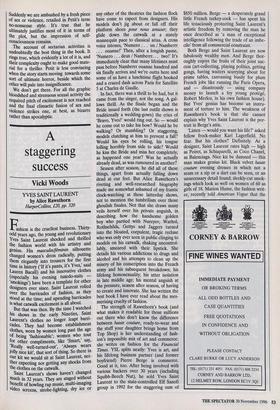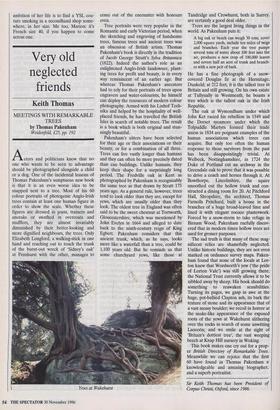A staggering success
Vicki Woods
YVES SAINT LAURENT by Alice Rawsthorn HarperCollins, £20, pp. 320 Fashion is the cruellest business. Thirty- odd years ago, the young and revolutionary Yves Saint Laurent shocked and thrilled the fashion world with his artistry and genius. His masculinIfeminin silhouette changed women's dress radically, putting them elegantly into trousers for the first tune in history Of it's pants, it's Yves,' said Lauren Bacall) and his innovative clothes (especially his evening tuxedo-suits _ stnokings) have been a template for other designers ever since. Saint Laurent rolled over the barricades of fashion, as they stood at the time; and upending barricades is what catwalk excitement is all about. . But that was then. By the time I watched his shows in the early Nineties, Saint Laurent's clothes no longer leapt barri- cades. They had become establishment Clothes, worn by women long past the age of being 'fashionable'; women who tout for other compliments, like 'Smart,' say, .Really well-turned-out', 'Always wears Jolly nice kit', that sort of thing. So there in our kit we would sit at Saint Laurent, nei- ther expecting nor getting any shocks from the clothes on the catwalk. Saint Laurent's shows haven't changed Inuch in 32 years. They are staged without benefit of howling rap music, multi-imaging video screens, strobe-lighting, dry ice or any other of the theatrics the fashion flock have come to expect from designers. His models don't jig about or fall off their platform shoes pour nous amuser; they glide down the catwalk at a stately mannequin pace to classical arias. A cross voice intones, `Numero . . an / Namberrr . . . ouanne!' Then, after a longish pause, `Numero . deux / Namberrr... two!' It's immediately clear that many lifetimes must pass before Namberrr ouanne handred and six finally arrives and we're outta here and some of us have a lunchtime flight booked and a crazed dash across Paris for Satellite 5 at Charles de Gaulle.
In fact, there was a thrill to be had, but it came from the singer, not the song. A gal- lows thrill. As the finale began and the Bride issued forth (the last outfit shown is traditionally a wedding-gown) the cries of 'Bravo, Yves!' would ring out. So — would he come out to take his bow? Would he be walking? Or stumbling? Or staggering, models clutching at him to prevent a fall? Would his eyes be rolling, his tongue lolling horribly from side to side? Would he kiss the Bride and miss her completely, as happened one year? Was he actually already dead, as was rumoured in another?
Season after season, he did all of these things, apart from actually falling down dead at our feet. But Alice Rawsthorn's riveting and well-researched biography made me somewhat ashamed of my frantic clock-watching at these latterday shows, not to mention the tumbrilism over those ghoulish finales. Not that she draws many veils herself over his private anguish, in describing how the handsome golden boy who partied with Nureyev, Warhol, Rothschilds, Gettys and Jaggers turned into the bloated, corpulent, tragic recluse who was only ever seen in public clinging to models on his catwalk, shaking uncontrol- lably, smeared with their lipstick. She details his various addictions to drugs and alcohol and his attempts to clean up the misery of his conscription into the French army and his subsequent breakdown; his lifelong homosexuality; his utter isolation in late middle age; his mental anguish at the pressure, season after season, of having to create and innovate. She has written the best book I have ever read about the mes- merising cruelty of fashion.
The strength of Rawsthorn's book (and what makes it readable for those millions out there who don't know the difference between haute couture, ready-to-wear and the stuff your daughter brings home from Top Shop) is her understanding of fash- ion's impossible mix of art and commerce: she writes on fashion for the Financial Times. YSL splits neatly: Yves is art, and his lifelong business partner (and former boyfriend) Pierre Berge is commerce. Good at it, too. After being involved with various backers over 30 years (including Squibb-Beech Nut), he sold Yves Saint Laurent to the state-controlled Elf Sanofi group in 1992 for the staggering sum of $850 million. Berge — a desperately grand little French turkey-cock — has spent his life tenaciously protecting Saint Laurent's artistic freedom by removing the man he once described as 'a man of exceptional intelligence following the trade of an imbe- cile' from all commercial constraint.
Both Berge and Saint Laurent are now fabulously wealthy men. And Berge thor- oughly enjoys the fruits of their joint suc- cess (art-collecting, playing politics, getting gongs, having waiters scurrying about for prime tables, canvassing busily for plum French jobs like running the Paris Opera, and — disastrously — using company money to launch a fey young protégé, Robert Merloz, in his own fashion house). But Yves' genius has become an instru- ment of torture to him. The weakness of Rawsthorn's book is that she cannot explain why Yves Saint Laurent is the por- trait in Berge's attic.
'Listen — would you want his life?' asked fellow frock-maker Karl Lagerfield. No fear. But his clothes? Definitely. As a designer, Saint Laurent rates high — high as Poiret, as Schiaparelli, as Coco Chanel, as Balenciaga. Nice kit be damned — this man makes genius kit. Black velvet haute couture evening dresses in which not a seam or a zip or a dart can be seen, or an unnecessary detail found; sleekly-cut smok- ings which look as well on women of 60 as girls of 18. Marion Hume, the fashion writ- er, recently told American Vogue that the ambition of her life is to find a YSL cou- ture smoking in a secondhand shop some- where, in her size. Me too, Marion: it's French size 40, if you happen to come across one.



















































































 Previous page
Previous page